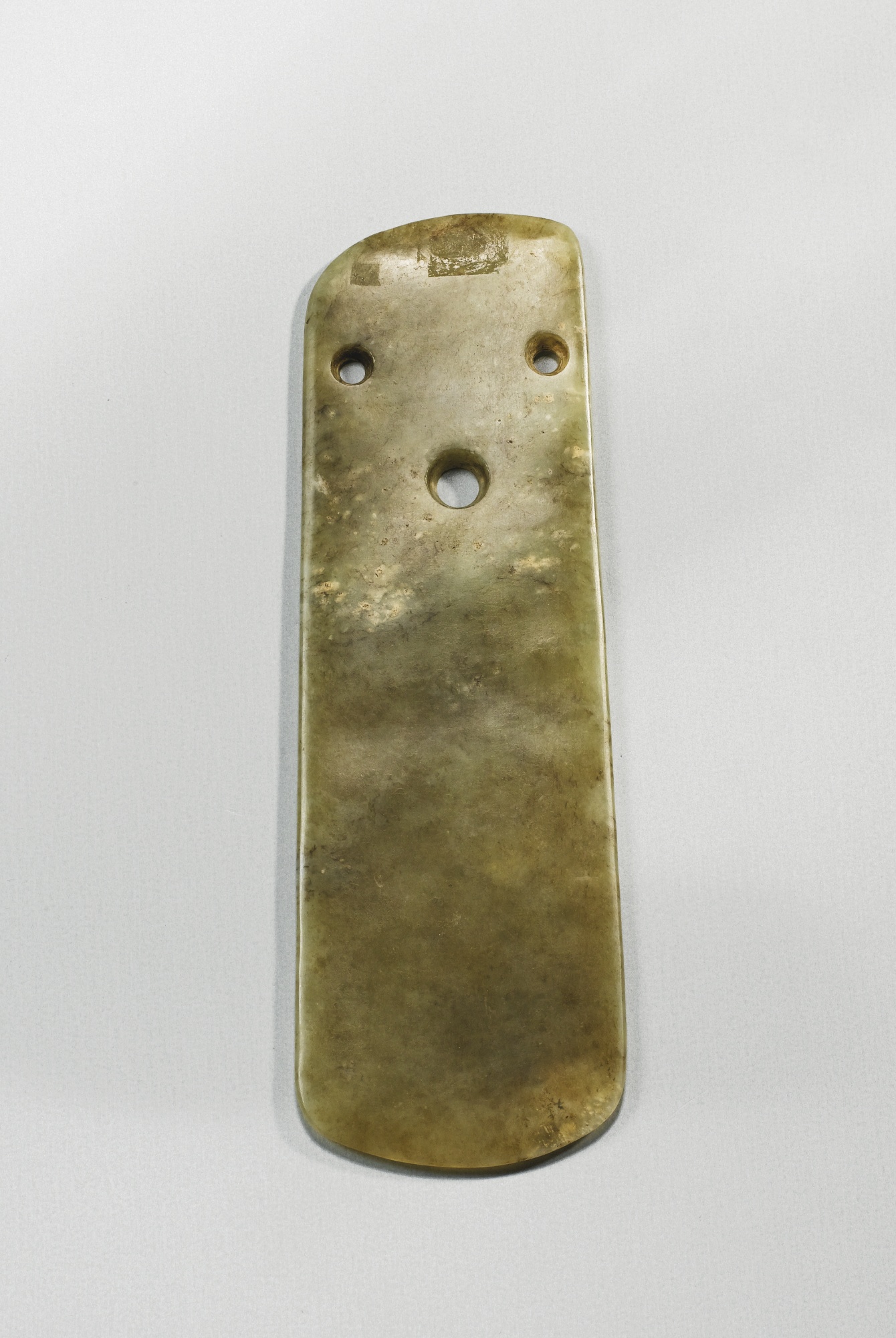A Chinese jade blade, Neolithic period. © Sotheby’s. The thin blade of slender oblong form, three sides cut with beveled edges, with three conically drilled holes at one end, the stone of yellowish-green color with some chalky-white inclusions. Length 8 1/8 in., 20.8 cm. Acquired in Connecticut, 19th October 1975.
From the article Department of Asian Art. “Neolithic Period in China.” In Heilbrunn Timeline of Art History. New York: The Metropolitan Museum of Art, 2000– (October 2004):
The Neolithic period, which began in China around 10,000 B.C. and concluded with the introduction of metallurgy about 8,000 years later, was characterized by the development of settled communities that relied primarily on farming and domesticated animals rather than hunting and gathering. In China, as in other areas of the world, Neolithic settlements grew up along the main river systems. Those that dominate the geography of China are the Yellow (central and northern China) and the Yangzi (southern and eastern China).
(…) A distinctly Chinese artistic tradition can be traced to the middle of the Neolithic period, about 4000 B.C. Two groups of artifacts provide the earliest surviving evidence of this tradition. It is now thought that these cultures developed their own traditions for the most part independently, creating distinctive kinds of architecture and types of burial customs, but with some communication and cultural exchange between them.
-
![[PDF]](https://www.eixdelmon.com/wp-content/plugins/papercite/img/pdf.png) E. Lyons, “Chinese Jades.,” , vol. 20, pp. 4-20.
E. Lyons, “Chinese Jades.,” , vol. 20, pp. 4-20.
[Bibtex]@Article{lyonschinesejades1978, author = {Lyons, Elizabeth}, title = {Chinese Jades.}, journaltitle = {Expedition}, date = {1978-04-30}, editor = {Penn Museum}, volume = {20}, pages = {4--20}, url = {http://www.penn.museum/sites/expedition/chinese-jades/}, file = {lyonschinesejades1978.pdf:media/trismegisto/Vitamin/Documents/Bibliography/lyonschinesejades1978.pdf:PDF}, owner = {trismegisto}, timestamp = {2016-08-15}, } - F. Salviati, Radiant Stones: Archaic Chinese Jades, Bilingual edition ed., Myrna Myers.
[Bibtex]@Book{Salviati2004, author = {Salviati, Filippo}, title = {Radiant Stones: Archaic Chinese Jades}, date = {2004-02-15}, edition = {Bilingual edition}, publisher = {Myrna Myers}, location = {Paris}, isbn = {978-1-58008-588-5}, pagetotal = {152}, url = {https://www.amazon.com/Radiant-Stones-Archaic-Chinese-Jades/dp/1580085881}, abstract = {Inextricably linked with Chinese civilization, jade played an essential, constituent role as a founding element in Chinese culture. Techniques of carving, the functions of the objects, and even the values related to jade were established during China’s period of formation, which spans the late Neolithic period to the age of the early empires. This is exactly the period to which the jades presented in {RADIANT} {STONES} belong: from the fourth millennium B.C.E. to the fourth century C.E., from the Neolithic period to the Han and Western Jin dynasties. In hundreds of color images, {RADIANT} {STONES} presents the ancient jades from the world-esteemed collection of Myrna and Samuel Myers. A catalog of ancient jades from the collection of Myrna and Samuel Myers. Includes full-page color plates of all the jades.}, owner = {trismegisto}, shorttitle = {Radiant Stones}, timestamp = {2016-08-15}, }








